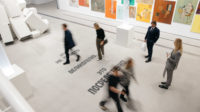Correction appended on February 27, 2009
Located just north of the city center, the Dallas Arts District, established in 1983, spreads across 68 acres, or 19 blocks—making it the largest of its kind in the nation. Beyond its impressive size, it boasts Renzo Piano's Nasher Sculpture Center (2003) and I.M. Pei's Meyerson Symphony Center (1989).
Now, it’s about to get a few more buildings by architectural heavyweights. Work is under way on the Center for the Performing Arts, which will feature venues by Norman Foster and Rem Koolhaas, along with Skidmore, Owings & Merrill. Once this $338 million undertaking is complete, the Dallas arts neighborhood will be one of the only places in the world where people can see the work of four Pritzker-Prize winners (Piano, Pei, Foster, and Koolhaas) within a single district.
The Center for the Performing Arts will consist of three major buildings woven together by a 10-acre park designed by the French landscape architect Michel Desvigne, with the Chicago-based firm JJR. Foster + Partners’ 234,000-square-foot Winspear Opera House calls for a 2,200-seat auditorium, contained within a cylindrical volume covered in red-tinted glass. A trellis-like canopy extends from the auditorium on all sides, shading an outdoor performance area.
The 600-seat, 80,000-square-foot Wyly Theater was designed, initially, by Koolhaas' Office of Metropolitan Architecture (OMA) and was taken over by REX, founded in 2006 by OMA alum's Joshua Prince-Ramus and Erez Ella. The design programmatically reshuffles typical horizontal theater layouts into a 12-level vertical expression, placing front-of-house and back-of-house areas above and below the auditorium, rather than around it.
SOM's City Performance Hall is organized as a series of sloping parallel concrete bands of varying heights and widths. Each band contains a single performance venue, which design partner Leigh Breslau, AIA, says will create easy-to-navigate circulation paths meant to aid the 70 groups that will use the building. As the only project in the center that is city-funded and dependent on bonds, Breslau says he designed it to be built as financing permits one section at a time, as a “continuous ribbon” that still maintains design coherence.
The center is not the only new addition to the arts district. A 170,000-square-foot expansion, designed by Allied Works, to the Booker T. Washington High School for the Performing and Visual Arts—a longtime presence in the neighborhood—was completed last June. Firm principal Brad Cloepfil, AIA, planned the addition as a series of masonry-clad interlocking bars, each dedicated to a particular curriculum. The earthy, industrial presentation of materials suggests artists' lofts, and in fact, Cloepfil says he thinks of the building in a "factory context" because "that's where artists are made."
Many hope the district will evolve into a pedestrian neighborhood of mixed-uses and artistic synergies in the middle of sprawl-laden Dallas. Arts district boosters say that having a public high school helps make the area an active community; housing and retail development should also prevent the district from becoming a cultural ghetto that empties out when the theaters are dark. But Cloepfil says it might be misguided to expect Jane Jacobs-style urbanism to sprout in north Texas, and that isn't necessarily a bad thing. Dallas might have to accept the arts district as a successful destination, not a way of life. "I'm trying to be a realist to other urban types," he says. "I do think there are other models of urban success that we may not want to believe are successful."
Correction: We originally stated that the Dallas Arts District will be the only place in the world where people can see the work of four Pritzker-Prize winners. This is inaccurate.















Post a comment to this article
Report Abusive Comment